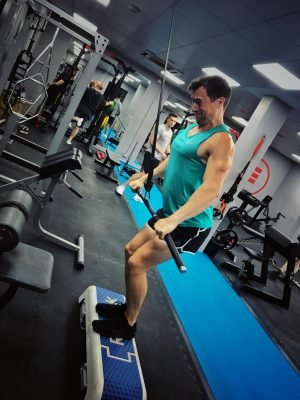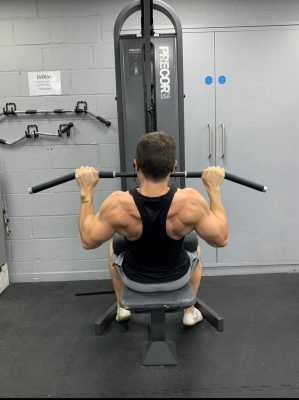The Evolve Team are all training for our annual photo shoot in six weeks time. We thought it would be fun to share some of our trainers’ training diaries, so you can see how PTs get themselves in shape. Tim Digan’s is here, Lee Bennett’s is here, Max Gingell’s is here, next up it’s the turn of Oliver Shermer.
Goals
This is my first shoot with Evolve Fitness, so I have less experience getting in shape for this kind of thing that some of the other trainers. I am largely being guided by their limited scraps of advice but I have a feeling they each have their own way and don’t wish to give away all of their secret weapons. My basic goal by the time of the shoot is to get appreciably leaner than I am now whilst still maintaining all of the lean muscle mass that I currently have. To be precise (or as precise as the expensive and mostly reliably piece of body composition analysis kit we have at the gym will allow) I am already lean at around 10% body fat as a proportion of my total weight with around 40kg of lean muscle. I figure that getting to around 8% with almost all of that lean mass will do nicely and yield a fairly impressive result (once I am lathered in tan and bathed in light from flattering angles, having just furiously thrashed out 1000 bodyweight dips and pullups in order to pump myself up and create even more of a spectacle). Although I clearly don’t have as much work to as others to lose fat, everyone’s goal is personal to them and it would be pointless committing to this if I wasn’t going to be in the best shape of my life, at least aesthetically.

Challenges
Generally the tactic for an uninitiated beginner would be to work out a figure for your daily basic caloric needs from food and then multiply this by a factor based on how active you are during each day. Ie how many calories does your body need to maintain the status quo based on the internal processes of your body, plus the demands of your job and any other physical activity you do.
You would then would choose a number below this in order to lose weight, the exact figure suggesting how aggressively or not you want to lose that weight. There are various formulas you can use (all Google-able, Schofield formula etc…) which allow you to get fairly close to this figure, but of course everyone’s metabolism and daily activities are different and it’s difficult to gain an accurate idea from a formula alone.
My advantage as a trainer is that I have plenty of experience tracking my own food intake and monitoring exactly what has happened to my body composition and I can fairly accurately cross reference that with my daily activities over the course of a long period of time. Nothing can really substitute for this in terms of knowing intuitively how much food – and therefore calories – is good for you. In my case, I know that with my current level of training, plus all the traipsing around I do on the gym floor with clients and the cycle commute, my daily need is in the region of 2700-2800 calories. It may be a little above or below that but however I’ve been counting my calories, that seems to work.
That point is significant. You may never be counting completely accurately and you may be making some mistakes, but as long as you are always making the same mistake and still achieving the result you want, then keep doing whatever you are doing. It’s working. Anyway, I reckon around a 300-400Kcal deficit will do me for what I want to achieve, so 2300-2400Kcal is my aim and I’ll see if that’s working after 3 weeks and if not, I’ll just take it down a few hundred more. The challenge, as with everyone is discipline (beer, whisky, chips, pizza…..).
The more acute your goal, the more discipline you need. As a trainer who is in good shape I know I have better discipline than most people, but I need to take it up a notch.

Nutrition
In terms of nutrition, the first consideration is in which ratio you should consume your macronutrients. The research tends to agree that in order to retain maximum lean muscle mass whilst in a deficit, you should aim to consume at least your usual amount of protein and for best results, perhaps higher. Sources that I like and trust put that figure at around 1-1.5g protein per pound of lean body weight. Some will quote higher, but having been eating in a narrow deficit for the last few months, that figure has helped me to retain all of the muscle mass I started with. From there I will work at around 0.5g fat per pound lean body weight and the remainder in calories will come from carbohydrates. The final strategy I’m throwing in here is to pick a couple of days a week where I will go no/very low carb. This is not traditional carb cycling as such, which again, you can Google.
My theory is just that if I weight my carb intake towards the first half of the week, I will have enough Glycogen stored in my muscles to feel good and train hard during my weekly training sessions.
If I then eat lower carb Thursday and Friday, I will be lower on stored Glycogen by Saturday and Sunday, when I usually tend to rest. In other words it’s a good way of achieving a larger calorie deficit without damaging my precious heavy training sessions. In a basic way I am trying to tailor my higher carb intake to when I most need them. I need my training sessions optimised in order to preserve my current strength levels and hold on to my overall muscle mass.
When ‘dieting,’ one thing that I find works really well for me is short periods of fasting. That is basically a glorified way of saying I skip breakfast and eat the first meal at lunchtime, having last eaten about 16 hours previously.
Nothing sciency here, just the psychological difference between eating 5-6 meals small meals and snacks rather than 3-4 normal sized meals in a day which both add up to the same amount of calories and macronutrients. I often actually feel sharper and less bloated if I just don’t eat before lunch (I may take in some coffee) and then I get to attack my 2300 calories in the second half of the day when I can enjoy larger meals and not feel as much like I am restricting myself. The mental aspect is the hardest part of restricting calorie intake and this seems to do the trick for me.
Other than that the other consideration is what foods I choose to eat but I that’s a whole other blog post. I will say that whatever the diet structure, the non negotiables for me are lots of fibrous veg and fruits/berries of varying colours, plenty of water and lots of good quality salt to replenish that lost during exercise. The micronutrient make up of these foods should always be factored into any diet so that we always looking at long term health outcomes, despite working my macronutrients around a short term goal.
What I will not be doing is “meal prep.” Whilst I do believe that the tactic of preparing each meal you eat in advance for the weak ahead is a useful motivational and organisational tool for some people, particularly those who have a very poor understanding of nutrition or struggle to control their caloric intake, I couldn’t do it myself. I am confident enough now in my ability to estimate calories and separate out food groups on the spot not to have to waste my Sunday preparing twenty five of the same bland meal just to not look forward to eating them the following week.
Food and particularly a large variety of food is one of life’s great pleasures and it’s not worth crippling your relationship with it for a marginally better aesthetic result. Getting in great shape does not need to mean cutting joy out of eating and that’s a dangerous stereotype that needs squashing. Don’t get my wrong, I might save some of the last night’s chilli in a tupperware for lunch next day, or make soup stock from the carcass of the roasted chicken, but that’s as far as I go.

Training
Training wise nothing much will change. I do plenty of cardio riding my bicycle to and from work, lift heavy and supplement that with gymnastic strength and skills training to avoid getting bored (hypertrophy training in large volume isn’t as appealing in a calorie deficit because it doesn’t really work that well and can be exhausting). Training with intensity will burn extra calories and prevent catabolism of my existing lean mass. No need to start running any marathons. You can’t outrun a bad diet.
To coincide with our big photo shoot push, we are offering 10% off our Six Week Body Transformation program, provided you sign up before December. So if you want to be in the shape of your life by Christmas, click the button below and get in touch!
At Evolve we’re super excited to be able to offer our own V02 Max testing facilities. Sign up below to be part of our trials and test out this advanced fitness testing technology completely free of charge. Just fill in your details and we’ll get back to you.
Evolve Gym 1 Cobb Street London E17LB
Email:
info@evolvefitness.co.uk
Phone:
020 8050 6956
Training Programmes
6 or 12 week intense transformation programme
The UK’s only group transformation programme
Training for longevity
Ongoing PT & Maintenance
1 month online intensive training course